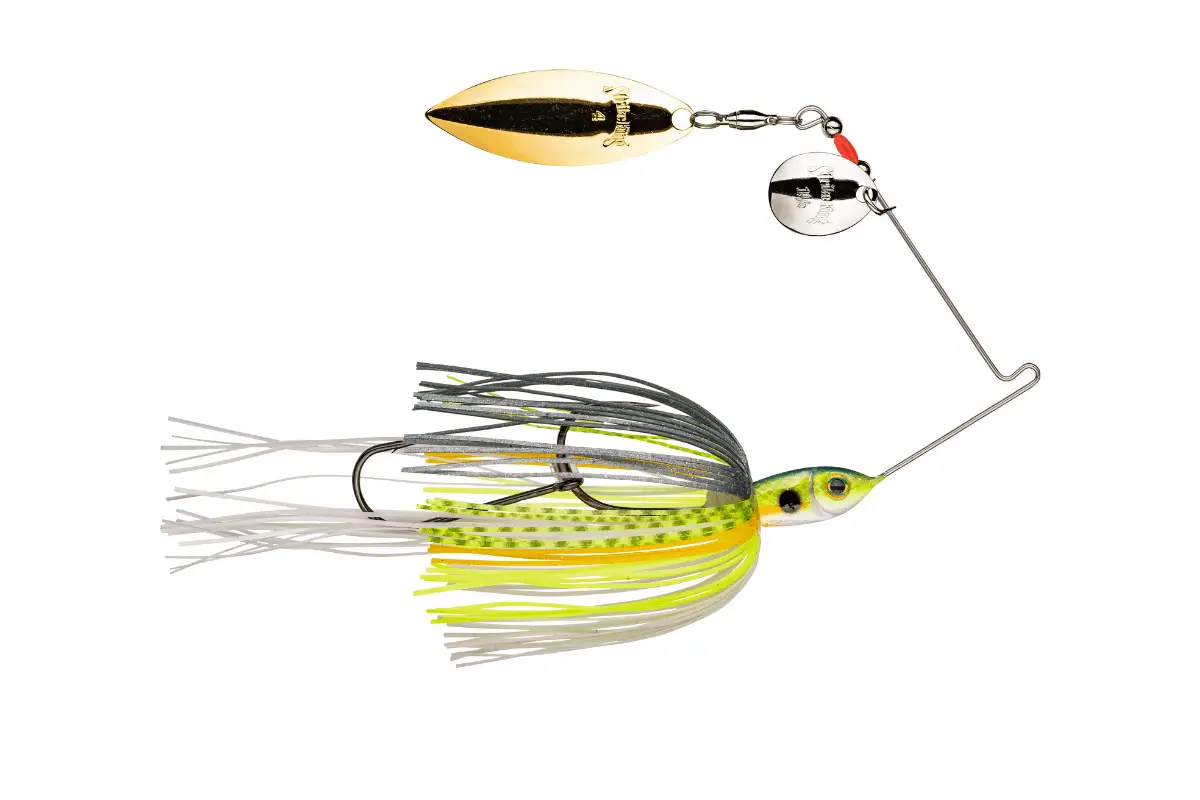Spinnerbaits have been a staple in the bass fishing world for many decades. The safety-pin wire bait excels in many situations and seasons, but it can really shine in the spring and fall.
To effectively and efficiently use a spinnerbait there are several key areas where an angler can adjust the lure to best match the conditions.
- Choosing the Best Blade Size, Color, and Shape
- Matching the Forage
- Adding Trailers or Trailer Hooks
- Matching the Water Clarity
- Keeping the Spinnerbait Running True
In this article, we will cover spinnerbaits in-depth to make sure you have the tools and understanding to make the most of this perennial fish catching machine.
The Bait
A spinnerbait is essentially any lure that uses a rotating blade. There are in-line spinners and safety-pin, or overhead, spinners.
This article will be discussing the traditional safety-pin style of spinnerbait that is most popular in the bass fishing world.
There have been literally hundreds, if not thousands, of spinnerbait designs and models developed over the years. Entire companies in the fishing industry have been born out of this singular lure.
Even with all of these modifications the basic lure design has remained the same.
A Big Fish Lure
There are certain lures that are known for catching bigger fish.
It is true that any lure can catch a lunker at any time, but the spinnerbait is one that has an uncanny ability to call up the larger bass in an area.
The spring and fall are the best-known spinnerbait seasons, yet the lure will catch fish all summer.
The simple and effective design makes the lure simple to fish. It casts easily and comes through a variety of cover well.
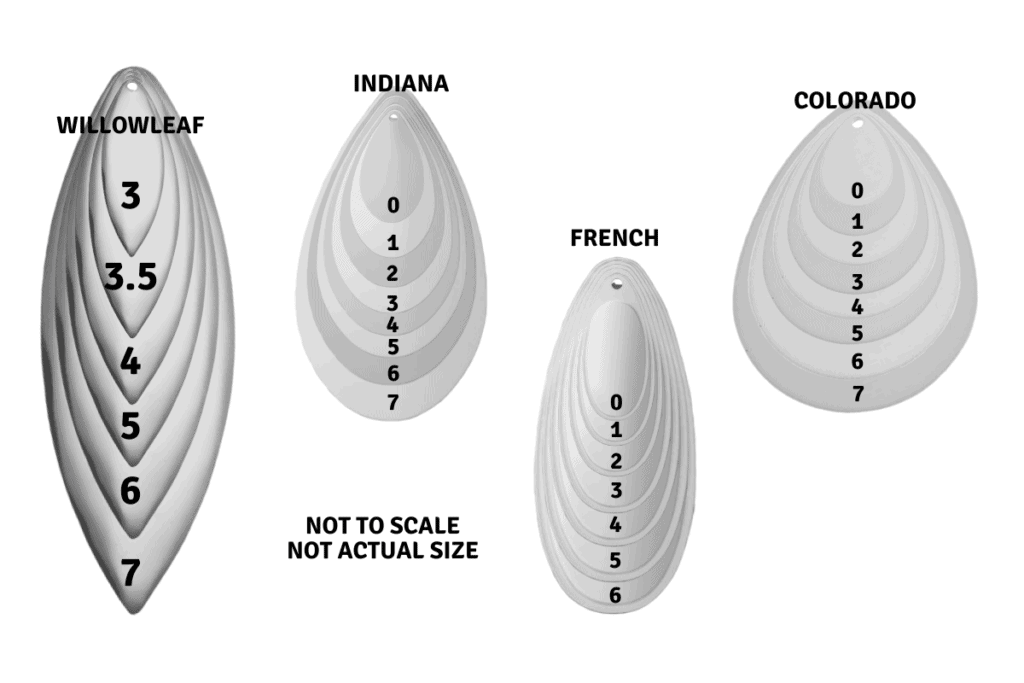
The Spinnerbait Blades
There are several common blade designs that are used on spinnerbaits.
- Willowleaf
- Colorado
- Indiana
- French
Willowleaf Blade
This is by far the most popular blade in the spinnerbait world. Most anglers are quite familiar with the long, slender profile of a willowleaf. It offers up the least amount of vibration but offers maximum flash.
The blade design mimics baitfish well and is a common choice when used to imitate shad.
Colorado Blade
This oblong blade is almost round, but not quite. It is often paired with a willowleaf to offer slightly more thump in the water.
Single Colorado blade spinnerbaits are common when anglers are fishing dirty water or in lowlight conditions.
Indiana Blade
This blade falls somewhere between the willowleaf profile and the Colorado design. Indiana blades are common and are seen on many models by various manufacturers.
The blade offers a mix of flash and thump that anglers find can call up bass in certain conditions.
French Blade
The French blade is not seen on standard factory offerings all that often. It has a cup in the center of the blade that creates a different vibration in the water column than the other blade designs.
Custom lure makers often will use a French blade as will anglers that wish to modify their standard spinnerbaits with something different.
Blade Size
Each blade comes in a variety of sizes. Die-hard spinnerbait aficionados will carry a box with them that has a plethora of loose blades in it.
Depending on the forage, the water clarity, and how the bass are striking the lure, a spinnerbait angler may change the blades out quickly to try a different offering.
Forage
If the primary forage is threadfin shad, a smaller blade is preferred. As the forage size increases, so should the blade size.
A number 7 is often swapped in when the main forage base are bluegill or gizzard shad. Both of these species grow to much larger sizes than the traditional threadfin shad or alewife.
Missed Strikes
If the bass seem to hit the spinnerbait but are failing to hook up, switching to a smaller blade can make a difference. They may be attacking the blades only and ignoring the rest of the bait.
Adding a plastic trailer or trailer hook can help the hook-up ratio, but that will be covered later.
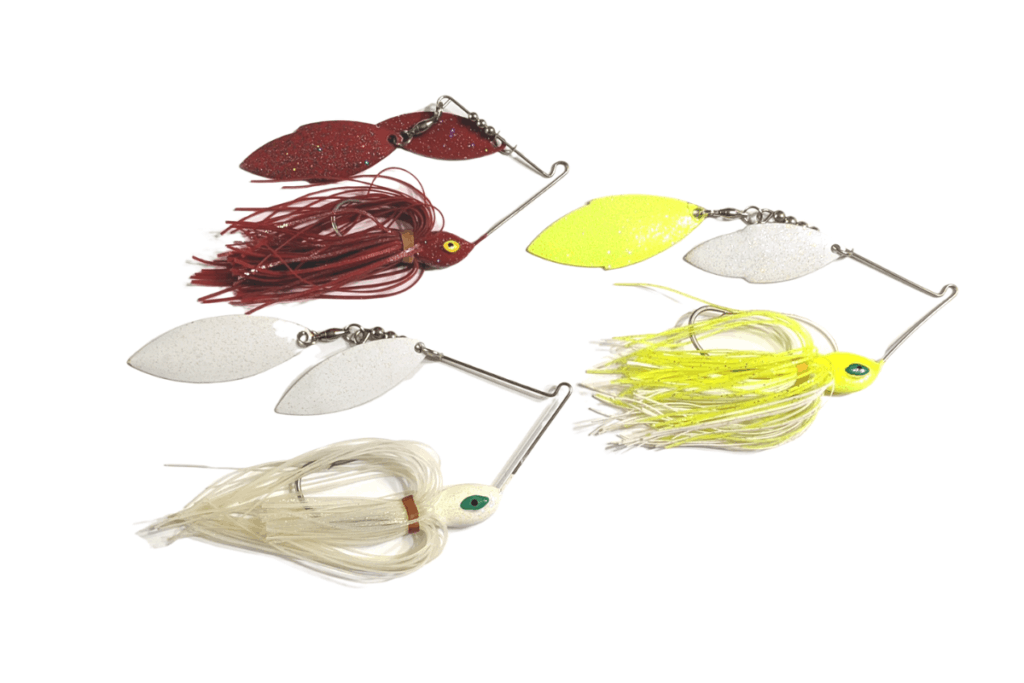
Spinnerbait Blade Color
The most common color combination for spinnerbait blades is a silver willowleaf partnered with either a silver or gold Colorado blade.
The options are endless though.
Blades also come in a range of painted options with some of the more popular versions being white, chartreuse, red, and orange.
The more solid and darker colored blades are most used in dirty to stained water conditions.
What are the Bass Eating?
The color choice of the spinnerbait should be dependent on the forage in the water that is being fished.
Probably the most common mistake I see is anglers throwing white or silver spinnerbaits in lakes, rivers, or ponds that have no shad in them.
These lures will still catch fish, but better luck may be had if the forage is properly taken into account – especially in clear water.
If the primary forage are bluegills or some sort of sunfish, the color of the spinnerbait should match. Many companies offer a color pattern that is actually called bluegill or sunfish.
Waters that have a heavy population of shad are great places to throw the silvers, whites, and grays. Shinier and translucent options are preferred during sunny days and solid colors are best on cloudy days.
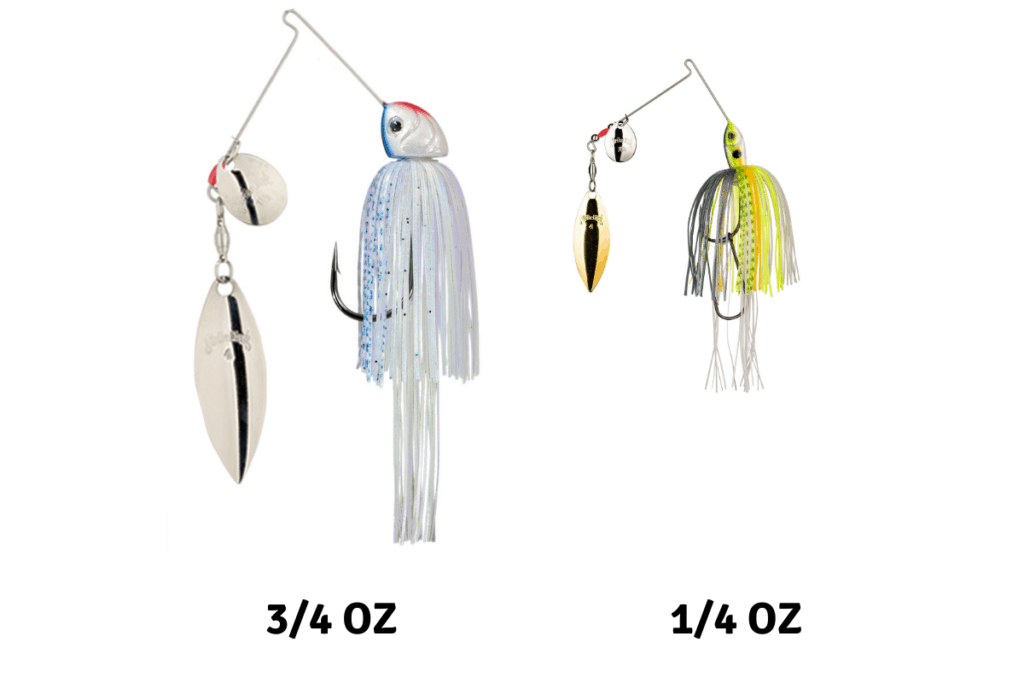
Spinnerbait Weight
Like most lures, spinnerbaits come in a range of sizes from micro offerings to heavy ledge thumpers that can work the depths.
For most bass fishing situations, a mixture of ½ oz and ⅜ oz spinnerbaits will work.
The ⅜ oz size is easier to keep up in the water column and fish over the top of shallow cover. It comes through vegetation and up-and-over wood well. It also does not need much speed to keep it going.
The ½ oz version is an excellent all-around choice that can be fished shallow or deep, and many spinnerbait anglers start with this size and adjust up or down from there.
Spinnerbaits that are ¾ oz and heavier are usually relegated for slow-rolling deep water.
Trailers and Trailer Hooks
Trailer Hook
There are two different schools of thought here. There are many anglers that always use a trailer hook on their spinnerbaits.
A trailer hook helps to catch those bass that short-strike the lure.
Keeping the hook free-swinging with a piece of surgical tubing between the trailer hook eye and barb of the primary hook is the best option for rigging. This allows the lure to come over cover and the hook can swing out of the way.
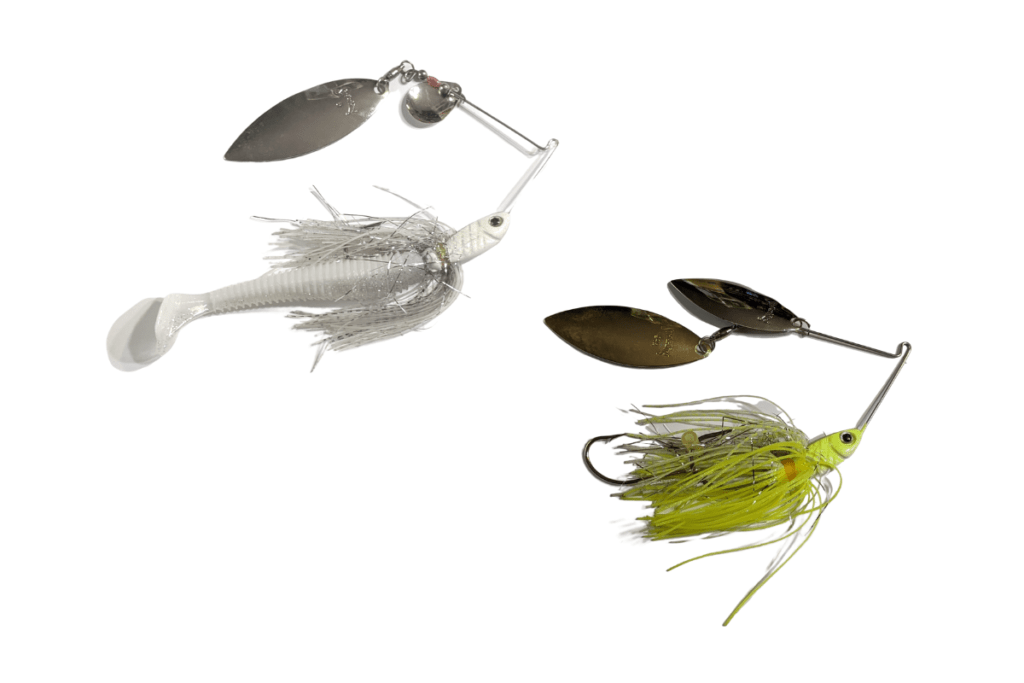
Soft Plastic Trailer
The other option to help the hook-up ratio is to add a plastic trailer. The addition of a soft plastic will draw the bass’s attention away from the blades and onto the body of the bait itself.
There are dozens of options for adding a trailer to a spinnerbait, but one of the more popular choices currently is a paddle tail swimbait.
Water Clarity
In clear water, it is best to match the forage of the lake or river and use natural colors. Sunny days make using willowleafs that reflect the light a solid choice.
On cloudy days or in stained to dirty water, solid colors are a better option. Dark colors, like black or black-blue, are also popular selections in dirty water.
Painted blades are also used in water with low visibility, with the one exception being when smallmouth are the targeted species. Smallies tend to love chartreuse blades and skirts even in clear water.
Shad Spawn
If the water that you fish the most contains shad, then using a spinnerbait during the shad spawn is a great choice.
Often, anglers will use smaller spinnerbaits in the ⅜ oz to ¼ oz range when targeting the threadfin or alewife spawn.
Closely matching the color and blade size can make a huge difference between catching a few bass and having an incredible outing.
This is where keeping a box full of extra blades comes in handy.
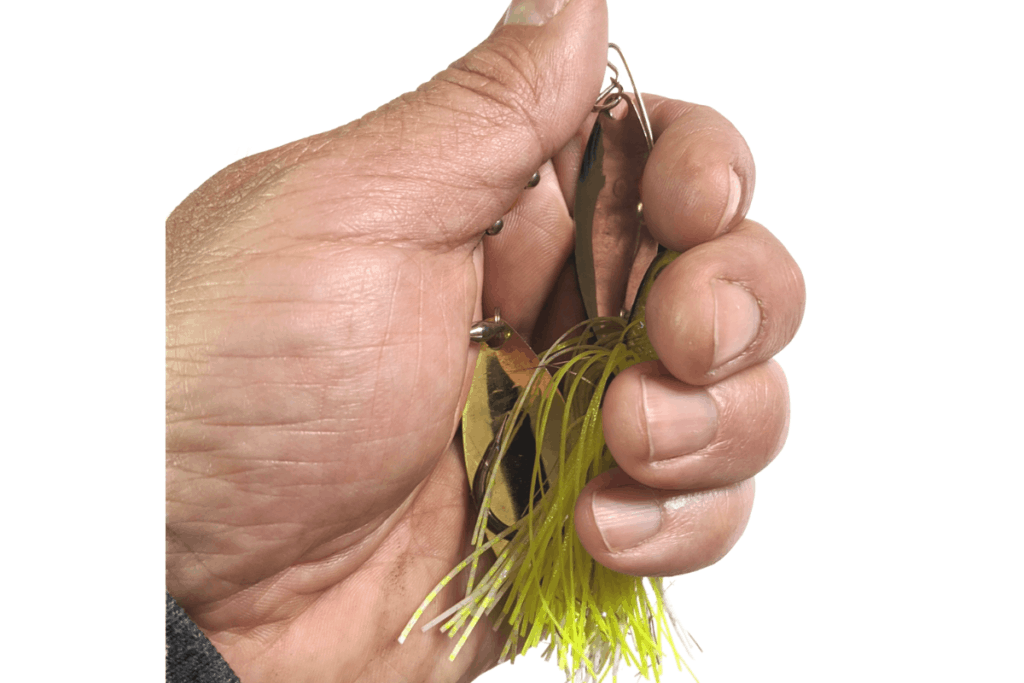
Tuning a Spinnerbait
Large bass can obliterate a spinnerbait and pull the wire arm out of shape. The result is a lure that is out of tune and runs at an awkward angle.
If the lure is running correctly, the blades should hold position directly over the body and hook of the bait.
When a lure is running out-of-tune, place it in the palm of your hand and squeeze the arm and body of the lure together. This will bring the proper shape back and the lure will run true again.
It is a good idea to squeeze the arm down and retune the bait every so often.
Final Thoughts
Spinnerbaits are common bass catching tools for millions of anglers – for good reason.
They have been proven fish catchers for many decades and manufacturers will keep pumping them out as long as bass swim the waters we fish. Just keep the following variables in mind when choosing and modifying your blade bait.
- Blade Design
- Blade Size
- Blade Color
- Forage in the Lake or River
- Spinnerbait Weight/Size
- Trailer Hook or Plastic Trailer
- Shad Spawn
- Keep the Lure in Tune
There are a lot of options for rigging up a spinnerbait and each angler can fine-tune these to his or her own liking. Using a lure right out of the package is going to work and catch fish as well.
Enjoy using this bait that has been catching bass longer than just about anything else in your tackle box. It is a good one.
Tight lines. Be safe and don’t forget to encourage someone today. You never know how you may change their life forever.
Isaiah 6:8

